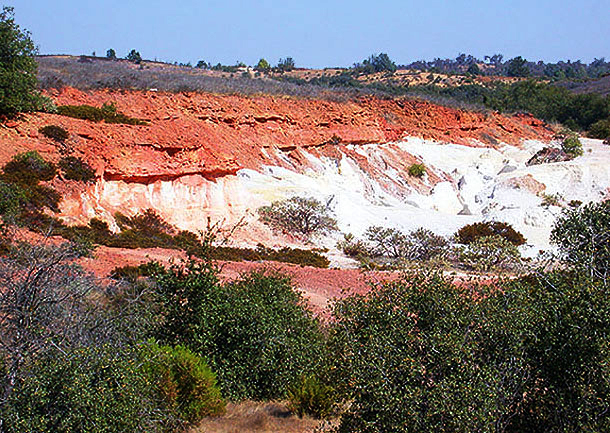
|
This is a classic, scenically striking geologic contact in the Middle Eocene Ione Formation, western foothills of the Sierra Nevada, Ione Basin, Amador County, California--many folks who observe this specific outcrop remark that it reminds them of similarly colored Mesozoic Era exposures in Utah, for example. It is an unfossilferous outcrop, but the geology of it is most-interesting. The whitish layer in the exposure is a massive, coarse sandstone (which elsewhere in the Ione Basin has been mined for its high silica content) that represents turbulent floodplain conditions some 48 million years ago during during Eocene geologic times. Above that massive white sandstone is a more thinly bedded deposit of feldspar-rich reddish-brown sandstones and shales; probably this too was deposited by rivers that periodically flooded their banks, but the mineral contact of the shales and sandstones is dramatically different than the essentially pure quartz content of the massive white sandstone below. The reddish-brown section contains much more feldspar and biotite, for example, which suggests that the environment was not as humid and hot; active chemical weathering was certainly not as effective as it had been during deposition of the massive white sandstone section. The contact is so dramatic, and the break in color, lithology and mineral content is so sharp and distinct, that most geologists consider this an excellent example of a specific type of unconformity (where there has been an interuption in the deposition of strata in a geologic section)--it's what geologists refer to as a disconformity--that is, neither the reddish-brown sandstones and shales, nor the massive white sandstones are tilted--they remain essentially flat-lying, giving the ostensible, yet misleading impression that deposition was continuous from the oldest to the youngest rocks in the geologic section. The "shrubs" in the foreground are actually immature scrub oaks of the Quercus berberidifolia variety--this is the most-common type of oak found on the harsh acidic soils in the so-called Ione chaparral, Ione Basin, California. Image snapped on October 14, 2002. I had long-wanted to get my late father, an Engineering Geologist, out to Lygodium Gulch, to observe first-hand the stratigraphy and geology of the area after paleobotanist Howard Schorn and I had quarried the fossil locality earlier that year, in late July and early August of 2002. Before the rains of Fall and Winter came, filling the fossil quarry with water (which would not evaporate completely until the following late Spring or Summer), we wanted to visit the site and conduct some additional explorations. Specifically, this would be a day's excursion combining elements of geology and paleobotany with botany--not only did I want Dad to take a look at the dig and the exposed geology, but I also wanted to snap a few images of the characteristic local living flora, such as maul oaks, Ione manzanita and a Digger Pine, or two, for good measure. We packed a lunch, filled our canteens, put in order our backpacks and scientific literature and headed out in the early morning of October 14, 2002, for the day's adventures. Please note: All fossil localities in the Ione Formation of Amador County, California, presently occur on private property; explicit permission from the land owners must be secured before collecting fossils there. |